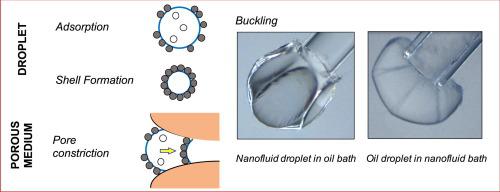Journal of Colloid and Interface Science ( IF 9.9 ) Pub Date : 2020-07-27 , DOI: 10.1016/j.jcis.2020.07.110 Q Liu 1 , Z Sun 2 , J Carlos Santamarina 1

|
Hypothesis
Particle accumulation at liquid-liquid or liquid-gas interfaces can significantly alter capillary behavior and give rise to unusual interfacial phenomena including the asymmetric macroscopic mechanical response of the interface.
Experiments
This study explores the accumulation of cetyltrimethylammonium bromide-modified nanoparticles at fluid interfaces and the subsequent mechanical response of nanoparticle-coated droplets during contraction and expansion. Droplet tests involve the simultaneous recording of the droplet shape and the capillary pressure. Complementary single-pore experiments examine the response of particle-coated interfaces as they traverse a pore constriction.
Findings
Interfaces promote order. The time-dependent nanoparticle accumulation at the interface is diffusion-controlled. The nanoparticle coated droplets can sustain negative capillary pressure before they buckle. Buckling patterns strongly depend on the boundary conditions: non-slip boundary conditions lead to crumples while slip boundary conditions result in just a few depressions. The particle-coated interface exhibits asymmetric behavior in response to particle-level capillary forces: an “oil droplet in a nanofluid bath” withstands a significantly higher capillary pressure difference than a “nanofluid droplet in an oil bath”. A first-order equilibrium analysis of interaction forces explains the asymmetric response. Single-constriction experiments show that the formation of particle-coated interfaces has a pronounced effect on fluid displacement in porous media.
中文翻译:

自组装的纳米颗粒涂层界面:毛细压力,壳形成和屈曲。
假设
液-液或液-气界面处的颗粒堆积会显着改变毛细管行为,并引起异常的界面现象,包括界面的不对称宏观机械响应。
实验
这项研究探索了十六烷基三甲基溴化铵修饰的纳米粒子在流体界面的积累以及在收缩和膨胀过程中纳米粒子包覆的液滴的后续机械响应。液滴测试包括同时记录液滴的形状和毛细压力。补充的单孔实验检查了颗粒涂层界面穿过孔道收缩时的响应。
发现
接口促进秩序。随时间变化的纳米粒子在界面处的积累受到扩散控制。纳米颗粒涂覆的液滴在弯曲之前可承受负毛细管压力。屈曲模式在很大程度上取决于边界条件:非滑动边界条件会导致皱缩,而滑动边界条件只会导致一些凹陷。颗粒涂层界面对颗粒级毛细作用力表现出不对称行为:“纳米流体浴中的油滴”比“油浴中的纳米流体滴”承受的毛细管压差明显更高。相互作用力的一阶平衡分析解释了不对称响应。



























 京公网安备 11010802027423号
京公网安备 11010802027423号